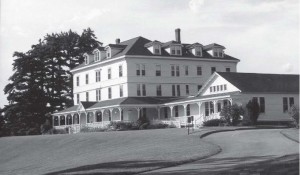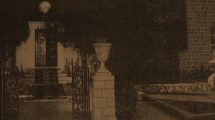 Dr. Genevieve Lenore Coy
Dr. Genevieve Lenore Coy
Born: 1886
Death: July 31, 1963
Place of Birth: near Chicago, Illinois
Location of Death: Africa
Burial Location: Rhodesia, Africa
Dr. Genevieve Coy received her doctorate in Education from Columbia University. She was a research assistant in educational psychology at the University of Illinois in Champaign.
Before she came into contact with the Bahá’í Faith in 1911, Dr. Coy composed a poem, “Let Me Know Life“, published in the early Bahá’í magazine, Star of the West (Vol. XXI. No. 4, July 1930, p.101), of which the editors wrote: “It was as if she had previously reached out subconsciously for truth and had arrived at an attitude of mind and spirit which made the truth of the Bahá’í Cause a complete fulfillment of her spiritual aspirations.” One felt that Genevieve Coy’s Bahá’í service was her grateful response to that fulfillment. [1]
There are few persons who remain among us who have had the bounty of meeting ‘Abdu’l-Bahá in person when he visited America. Most Bahá’ís have no experience, therefore, of hearing about such meetings first-hand. So, it seems appropriate now to republish some of the more touching accounts of meetings with the Master. Those collected in this book were chosen almost at random: the notes of Roy Wilhelm, Stanwood Cobb, and Genevieve Coy.[2]
Of the many articles contributed by Dr. Coy to Bahá’í publications over the years, none is more precious than the account of her pilgrimage to the Holy Land, made between September 1st through 8th, 1920, in company with Mabel and Sylvia Paine, and Cora Grey. Genevieve recounts this visit in several issues of Star of the West (Vol. XII, Nos. 10-13, September through November 1921, pp. 163-214) From her touching word portrait of the Master is derived, too, a portrait of Genevieve Coy:
“It is very difficult to remember much of what of He said. Indeed, it was almost difficult to listen! I wished only to look and look at the beauty of His face! For that was what impressed me first, the exquisite beauty of the Master. It was like the most beautiful picture we have of Him, with life and color added. His is a face of living silver – the wonderful silver of hair and beard, and the blue of His eyes. The side face is majestic and sweet and loving. It was that which we saw most of the time. The full face is more dignified; to me it seemed more awe-inspiring. And yet, when He smiled, it was most exquisitely friendly, and human! But He looked very, very tired …and yet the weariness was not, I think, a weariness of spirit. I cannot tell why I feel that way, partly because He can reach, as no one else can, the infinite sources of spiritual strength.
“I had no desire to speak to the Master; there was nothing that I could say. I do not know what happened in my mind and heart. There was no shock, no surprise, no sadness, no thought of my own faulty past. But I came to understand that for one who has been long in His presence, there can be no desire except to serve Him; that one’s life would be happy only as one pleased Him; that one would be sad only as one grieved Him. I felt then that I had begun to learn — that the will to serve was becoming greater as I had prayed that it might.. .”[1]
Dr. Genevieve Coy went on pilgrimage in 1920, in the company of three other Bahá’í women. They stayed for one week. Her account is valuable in that it holds more details about the daily aspects of her visit. We note that the spread of the Faith around the world was now reflected in the Master’s Household: Khusraw, from Burma; Fujita, from Japan; and Mrs. Emogene Hoagg, from America, were serving in the Holy Land. More than thirty pilgrims — from Asia and Europe, as well as the United States — were ‘Abdu’l-Bahá’s guests, including one from Ashkhabad (`Ishqábád), in Russian Turkestan, where the first Bahá’í Temple had been completed.
 Genevieve Coy’s pilgrimage had a tremendous influence on her life. Within a few months, at the request of ‘Abdu’l-Bahá, she was on her way to Tehran to teach in the Bahá’í School for girls. Returning to America, some years later, she served as a member of the Spiritual Assembly of the Bahá’ís of New York City, as an administrator of the Green Acre Bahá’í School, and in various other capacities.[2]
Genevieve Coy’s pilgrimage had a tremendous influence on her life. Within a few months, at the request of ‘Abdu’l-Bahá, she was on her way to Tehran to teach in the Bahá’í School for girls. Returning to America, some years later, she served as a member of the Spiritual Assembly of the Bahá’ís of New York City, as an administrator of the Green Acre Bahá’í School, and in various other capacities.[2]
In May 1958 she volunteered to pioneer to Africa and lived at the Salisbury Bahá’í National Center for awhile allowing the Bahá’í friends to learn from her until her death in 1963. She was the first white woman to be buried in a non-white cemetery.
Source:
1 Reed, Dorothea Morrell. “Dr. Genevieve Leroy Coy” bahaiheoresheroines.blogspot.com
2 Wilhelm, Roy; Cobb, Stanwood; and Coy, Genevieve. “In His Presence: Visits to ‘Abdu’l-Baha” Bahai-Library.com: Winters, Jonah
Images:
Baha’i World Centre Archives




